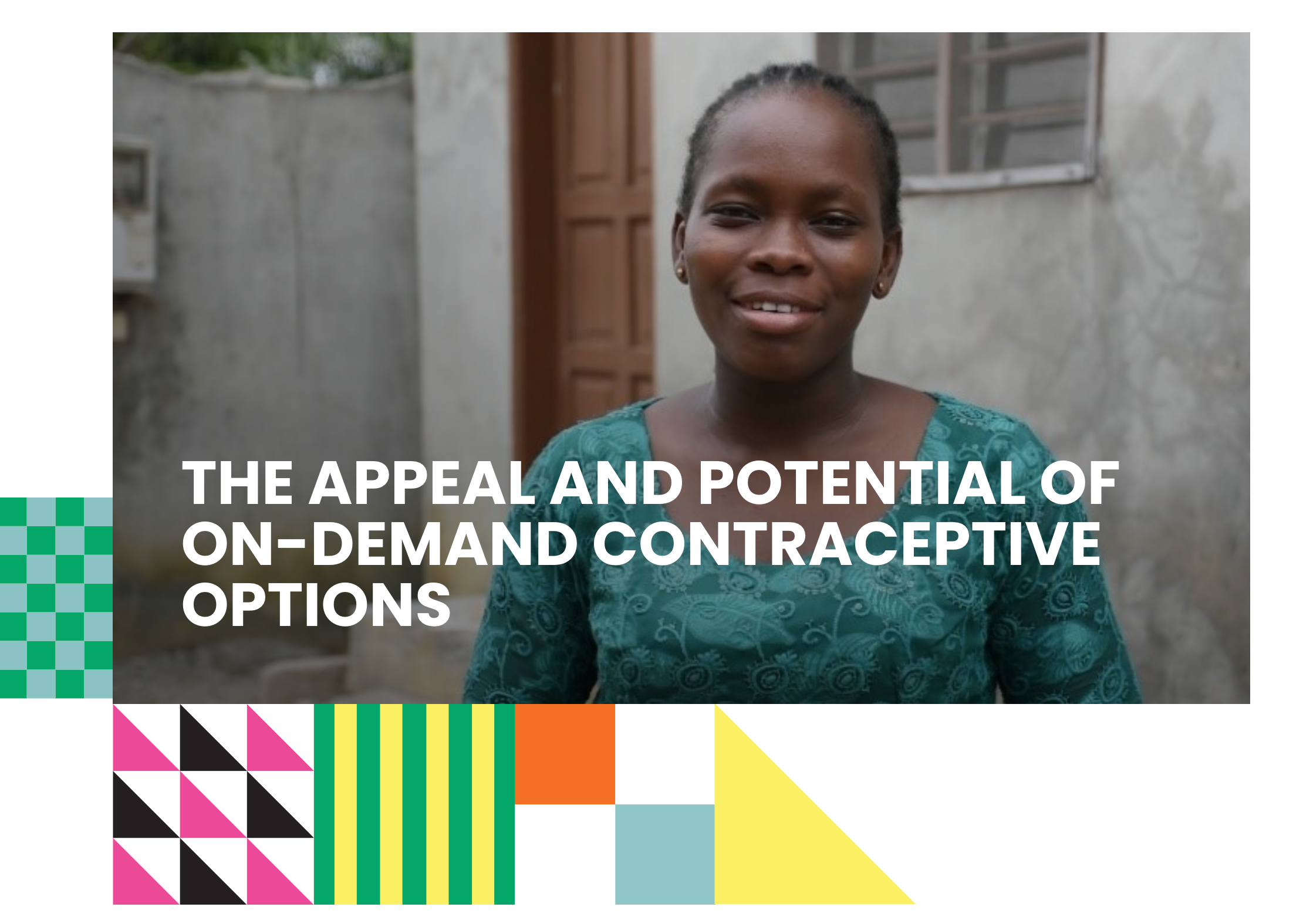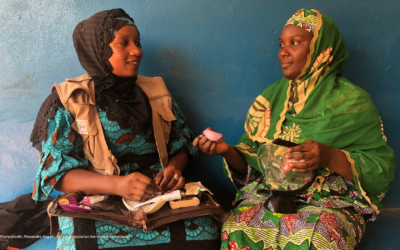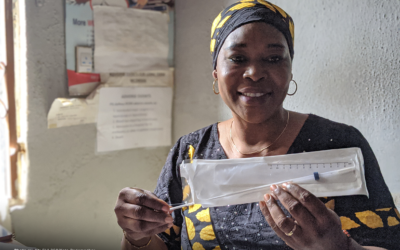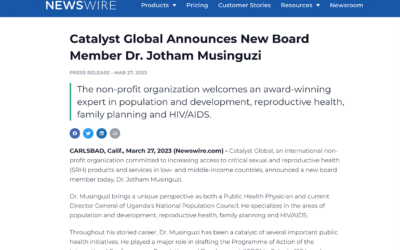By Ashley Jackson, Deputy Project Director, Expanding Effective Contraceptive Options, and Léonce Dossou, Mass Media Communications, Sales, and Distribution Manager, L’Association Béninoise pour le Marketing Social et la Communication pour la Santé
Péniel, age 23, and Valérie, age 42, both use contraception – but only when they have sex.
“I am not living with my man at the moment, but he comes over from time to time,” Péniel shares.
Péniel didn’t feel like oral contraceptive pills and condoms were right for her. She worried she would forget her pills, or that her partner would use a condom incorrectly.
For Valérie too, sex happens intermittently. “When my husband comes back from his travels,” she explains. “Not every day.”
“I was hesitant about other methods,” Valérie adds. She wants her contraception to be discreet, easy to use, non-hormonal, and without side effects.
These women – like the 1.1 billion sexually active women globally who do not want to get pregnant – need options to prevent pregnancy on their own terms.
When a new on-demand, self-care contraceptive product first arrived in Benin, Péniel and Valérie were among the first in their community to line up for the Caya® diaphragm. https://www.youtube.com/embed/rSMCpknNrxw?feature=oembed
THE CASE FOR ON-DEMAND CONTRACEPTION
Consumers need a range of effective contraceptive options that meet their varied preferences, including the preference for on-demand contraception—especially among those who have infrequent sex.
Globally, the two most common reasons women give for not using contraception while in need are:
– “Health concerns,” including health risks, fears of side effects, and unwanted menstrual changes.
– “Infrequent sex.” Women who are unmarried and those who do not have children are more likely than others to say infrequent sex is why they do not use contraception.
Across a wide range of countries, studies have found an interest in on-demand options among women who have infrequent sex, many of whom desire convenience, ease of remembering, the ability to conceal use and the avoidance of continuous exposure to contraceptive hormones and/or side effects.
But for consumers who want contraception only at or around the time of sex, what on-demand options really exist?
THE NARROW RANGE OF CURRENT ON-DEMAND OPTIONS
The range of on-demand options on the market is limited. Only three options are widely available: Withdrawal is one of the most common traditional methods of family planning. No product is needed. However, this approach is less effective than modern contraceptive methods.
– Male and female condoms are the preferred modern methods for many. These non-hormonal barrier methods provide protection against HIV and other sexually transmitted infections in addition to contraception. But condoms do not satisfy the entire universe of consumers with a desire for on-demand contraception. Many consumers report they do not use condoms due to dislike of the physical sensation of use, social stigma, lack of male partner support, and other reasons.
– Emergency contraceptive pills (ECPs) can be taken up to 5 days after sex. (The sooner they are taken, the more likely they are to be effective.) Unlike other modern methods, ECPs do not need to be accessed before sex—making this method particularly valuable when sex is unplanned. Yet some consumers, like Valérie, desire a non-hormonal option. In addition, regular use of ECPs is not yet authorized by national regulatory authorities.
MIGHT NEW ON-DEMAND CONTRACEPTIVE METHODS FILL A MARKET GAP?
OPTIONS ON THE HORIZON
Research shows that on-demand options have enormous potential to respond to consumer preferences. Yet of the USD $64 million spent globally on contraceptive technology development in 2018, just $3.7 million (5.7 percent) went to on-demand methods, according to the 2020 G-FINDER Report.
Three on-demand methods have the potential to become more widely available by 2025:
– Pericoital oral contraception could address a need for women who want the option to use a contraceptive pill before or after sex, as needed. A review of 19 studies in 16 countries found substantial interest among women in a pericoital pill that could be taken repeatedly. Research by the World Health Organization supports the safety and efficacy of this use of LNG 1.5 mg pills, the same formulation of many current ECPs, multiple times within a menstrual cycle. Furthermore, recent (pre-published) research in Ghana and Kenya showed demand and high satisfaction with this method. Discussions are underway with regulatory bodies about the possibility of authorization of this method.
– Vaginal contraceptive gels, such as spermicidal gels, can be self-inserted in the vagina before sex to stop fertilization. A new type of gel may enter more markets soon: Phexxi®, which prevents pregnancy by maintaining vaginal pH, received U.S. Food & Drug Administration (FDA) approval in 2020.
– Diaphragms are a barrier method placed over the cervix during sex. Caya® departs from past diaphragms primarily because it comes in a single size, meaning it requires no fitting by a provider. With approvals by Stringent Regulatory Authorities and several dozen other countries, including three in sub-Saharan Africa (Benin, Niger, and Nigeria), Caya access may soon increase—including in countries that have never had widespread diaphragm access.
EECO and Knowledge SUCCESS curated a collection of 20 Essential Resources for Contraceptive Product Introduction. The selected resources can support efforts by program planners and implementers to bring to market the new contraceptive products that consumers want, including on-demand options.
PENIEL AND VALERIE’S CHOICE: A SINGLE-SIZE DIAPHRAGM
“When he comes over and I’m ovulating, I use Caya to prevent pregnancy for now,” Péniel says.
In Benin and Niger, EECO project monitoring and user research have found that infrequent sex and a preference for on-demand contraception motivated many women like Péniel and Valérie to choose the Caya diaphragm.
Péniel and Valérie accessed the Caya diaphragm through USAID’s Expanding Effective Contraceptive Options (EECO) project, which leads pilot introductions of promising contraceptive methods. Through EECO, PSI’s network member in Benin, the Association Béninoise pour le Marketing Social et la Communication pour la Santé (ABMS), supports providers to offer Caya alongside a wide range of contraceptive options.
ABMS communicates with women and men about the possibility of pairing Caya with the fertility awareness-based Standard Days Method, which is available in the same clinics that offer Caya. On fertile days, some clients choose to use Caya rather than abstaining or using condoms.
To address unmet need among consumers who have infrequent sex and are dissatisfied with current contraception options, there’s more work to do. When pharmaceutical companies and donors invest in developing novel on-demand methods and when we collectively increase consumer access to available products, we put the power of choice into the hands of consumers like Péniel and Valérie.
“[Caya] is a very easy method to use,” Valérie explains. “It’s discreet… practical, and without side effects and hormones.”
Simply, it’s contraception on her terms.
For more information, please contact Ashley Jackson ([email protected]).
Original post published by PSI: https://www.psi.org/2021/12/the-appeal-and-potential-of-on-demand-contraceptive-options/




